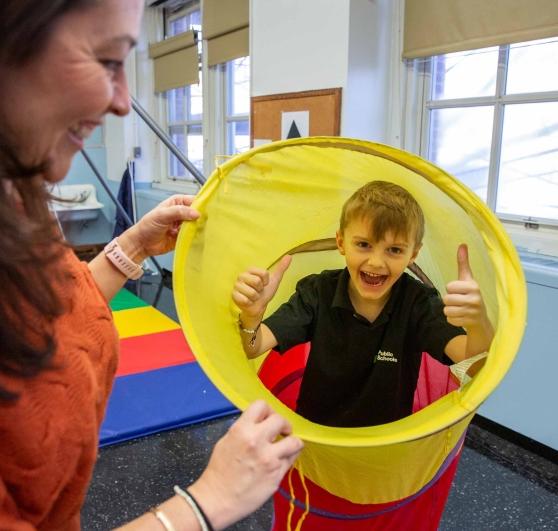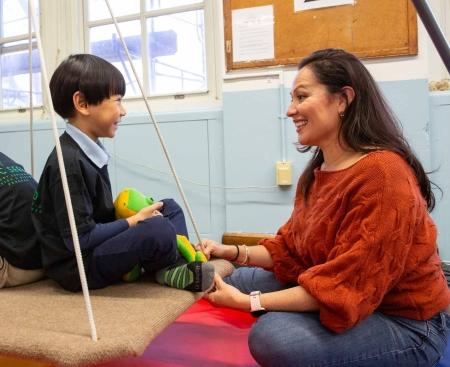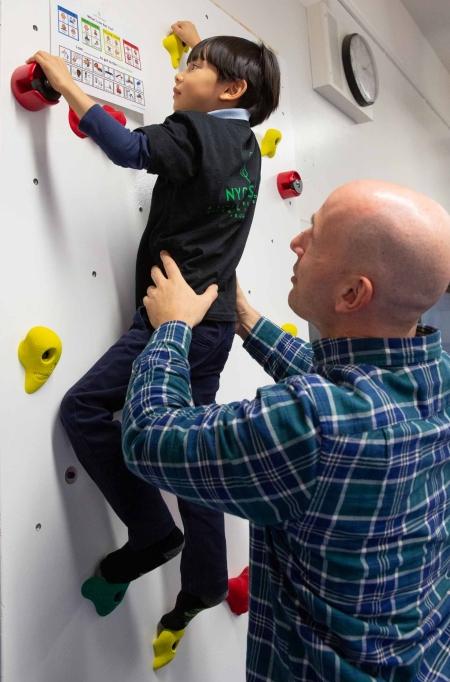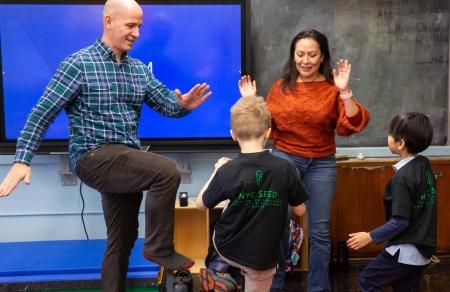A ‘sense’ of what some students need

A 1st-grader shows his excitement after crawling through a tunnel.

A student uses the swing, guided by PT Ximena Zambrano.
Aldijana Jarovic’s son, a 1st-grader at PS 171 in Astoria, Queens, used to struggle daily with homework. Now, he’s ready to focus almost every afternoon. Jarovic attributes the change to the school’s Sensory Exploration, Education and Discovery (SEED) program.
The SEED program is a citywide initiative run by occupational and physical therapists in 78 schools, including six preschool centers, citywide. It takes place in a special room that looks like a playground. There’s a rock-climbing wall, a brightly colored tunnel to crawl through, a swing and a trampoline. Although it’s a fun place to be, these components are powerful tools to address sensory needs in children with autism spectrum disorders, ADHD or other sensory and self-regulation issues that qualify them for occupational or physical therapy.
“Children learn in different ways,” explained Philippe Bourgoing, an occupational therapist at PS 171 who delivers SEED programming with his colleague, Penelope Sovaras. “It’s not always sitting still and listening — some children need movement or touch to regulate their body and stay focused.”
The tools in the SEED room help the therapists to identify what type of movement or touch students need at a given time. In a typical session, held after school or on the weekend, therapists lead students through activity stations, helping them understand and experience different sensory input. As they interact with the toys and equipment, students learn to identify and express how they’re feeling and what type of input or movement they need to calm down or become more alert. Therapists also meet with the students’ parents and teachers to carry those tools and insights into the classroom and home.
“It’s truly useful,” said Melina Baez, a 1st-grade teacher who has three students in the program. After visiting the SEED room, Baez brought a “calm-down corner” with a weighted snake toy named Snakey into her classroom. She said her students are “able to self-soothe before it escalates to the point where it’s hard to bring them back to learning,” which not only helps the student in need but means “less disruption” for the rest of the class, she said.
Alyssa Goldinger, the UFT chapter leader at the school, was “really excited” when she heard that SEED was coming to PS 171. When the delivery of the equipment was delayed by a year, Bourgoing and Sovaras impressed her by “improvising” solutions to deliver therapy to their students.
Solaras said she’s seen children with autism spectrum disorders become empowered and more autonomous as a result of their participation in the SEED program.
“They’re using the strategies that work for them and becoming part of society,” she said. “Now you get to know them as a person, and it’s beautiful.”

